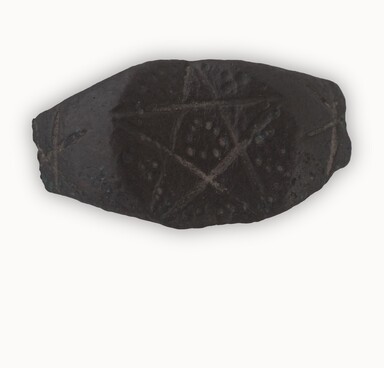The Kursk Regional Museum of Archaeology holds a pendant dating from the first half of the 11th — the turn of the 12th centuries. It was discovered by Olga Nikolaevna Enukova, an expert in the history of Ancient Rus’, during archaeological excavations on the territory of the Lipinski archaeological complex in the Kursk region in 2001. The ornament was discovered during the sampling of soil from pit No. 70A. The fill consisted of gray layer material, in the lower part of which the remains of a clay oven were traced.
The museum exhibit is a cast openwork bronze pendant that has fully retained its shape, including the eye. The pendant was part of a woman’s costume. As a rule, such things were worn around the neck separately on a lace or as part of a necklace. The ornamental motifs on the piece are also wonderfully preserved: on the obverse there is a clear ornament with a stylized depiction of a beast leaning on a frame with two paws and a mask above the eye.
On the territory of the present-day Kursk region there are a few known finds that are stylistically close to the objects of the Scandinavian circle of antiquities. A typologically similar pendant was accidentally found in the Ratsky archaeological complex in the Kursk region. The ornament on the Lipinski pendant is only an imitation of the above-described find from the Ratsky complex. This is evidenced by both the overall shape of the item, and the similar location of the holes. However, the ornament does not show any connection with the zoomorphic motif of the prototype, it is more reminiscent of Old Russian entrelac design, a type of ancient ornament.
Outside the area of present-day Kursk, artifacts of this type were recorded in 2000 as part of the Kiev hoard, which is dated to the middle — the second half of the 5th century, and in Skemo (Norway). The ornaments from the burial mound No. 78 of the Shestovitsa Graveyard (Chernihiv Region, Ukraine), the Gnezdov Hoard of 1868 (Smolensk Region, Russia), the hoard from Verby (Sweden) and the burials No. 371 and No. 791 of the Birks Graveyard (Sweden) are typologically close. The only difference between these types of pendants is that in one case the animal’s head has no ears, and in the other, by contrast, they are quite large.
The museum exhibit is a cast openwork bronze pendant that has fully retained its shape, including the eye. The pendant was part of a woman’s costume. As a rule, such things were worn around the neck separately on a lace or as part of a necklace. The ornamental motifs on the piece are also wonderfully preserved: on the obverse there is a clear ornament with a stylized depiction of a beast leaning on a frame with two paws and a mask above the eye.
On the territory of the present-day Kursk region there are a few known finds that are stylistically close to the objects of the Scandinavian circle of antiquities. A typologically similar pendant was accidentally found in the Ratsky archaeological complex in the Kursk region. The ornament on the Lipinski pendant is only an imitation of the above-described find from the Ratsky complex. This is evidenced by both the overall shape of the item, and the similar location of the holes. However, the ornament does not show any connection with the zoomorphic motif of the prototype, it is more reminiscent of Old Russian entrelac design, a type of ancient ornament.
Outside the area of present-day Kursk, artifacts of this type were recorded in 2000 as part of the Kiev hoard, which is dated to the middle — the second half of the 5th century, and in Skemo (Norway). The ornaments from the burial mound No. 78 of the Shestovitsa Graveyard (Chernihiv Region, Ukraine), the Gnezdov Hoard of 1868 (Smolensk Region, Russia), the hoard from Verby (Sweden) and the burials No. 371 and No. 791 of the Birks Graveyard (Sweden) are typologically close. The only difference between these types of pendants is that in one case the animal’s head has no ears, and in the other, by contrast, they are quite large.





